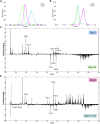Lipid Analysis of Fracture Hematoma With MALDI-MSI: Specific Lipids are Associated to Bone Fracture Healing Over Time
- PMID: 35309042
- PMCID: PMC8927282
- DOI: 10.3389/fchem.2021.780626
Lipid Analysis of Fracture Hematoma With MALDI-MSI: Specific Lipids are Associated to Bone Fracture Healing Over Time
Abstract
Background: Fracture healing is a complex process, involving cell-cell interactions, various cytokines, and growth factors. Although fracture treatment improved over the last decades, a substantial part of all fractures shows delayed or absent healing. The fracture hematoma (fxh) is known to have a relevant role in this process, while the exact mechanisms by which it influences fracture healing are poorly understood. To improve strategies in fracture treatment, regulatory pathways in fracture healing need to be investigated. Lipids are important molecules in cellular signaling, inflammation, and metabolism, as well as key structural components of the cell. Analysis of the lipid spectrum in fxh may therefore reflect important events during the early healing phase. This study aims to develop a protocol for the determination of lipid signals over time, and the identification of lipids that contribute to these signals, with matrix-assisted laser desorption/ionization mass spectrometry imaging (MALDI-MSI) in fxh in healthy fracture healing. Methods: Twelve fxh samples (6 porcine; 6 human) were surgically removed, snap frozen, sectioned, washed, and analyzed using MALDI-MSI in positive and negative ion mode at different time points after fracture (porcine: 72 h; human samples: range 1-19 days). A tissue preparation protocol for lipid analysis in fxh has been developed with both porcine and human fxh. Data were analyzed through principal component- and linear discriminant analyses. Results: A protocol for the preparation of fxh sections was developed and optimized. Although hematoma is a heterogeneous tissue, the intra-variability within fxh was smaller than the inter-variability between fxh. Distinctive m/z values were detected that contributed to the separation of three different fxh age groups: early (1-3 days), middle (6-10 days), and late (12-19 days). Identification of the distinctive m/z values provided a panel of specific lipids that showed a time dependent expression within fxh. Conclusion: This study shows that MALDI-MSI is a suitable analytical tool for lipid analysis in fxh and that lipid patterns within fxh are time-dependent. These lipid patterns within fxh may serve as a future diagnostic tool. These findings warrant further research into fxh analysis using MALDI-MSI and its possible clinical implications in fracture treatment.
Keywords: MALDI-MSI; fracture healing; fracture hematoma; lipids; sample preparation.
Copyright © 2022 Groven, Nauta, Gruisen, Claes, Greven, van Griensven, Poeze, Heeren, Porta Siegel, Cillero-Pastor and Blokhuis.
Conflict of interest statement
The authors declare that the research was conducted in the absence of any commercial or financial relationships that could be construed as a potential conflict of interest.
Figures






Similar articles
-
Fracture haematoma proteomics.Bone Joint Res. 2024 May 3;13(5):214-225. doi: 10.1302/2046-3758.135.BJR-2023-0323.R1. Bone Joint Res. 2024. PMID: 38699779 Free PMC article.
-
Enhanced capabilities for imaging gangliosides in murine brain with matrix-assisted laser desorption/ionization and desorption electrospray ionization mass spectrometry coupled to ion mobility separation.Methods. 2016 Jul 15;104:69-78. doi: 10.1016/j.ymeth.2016.02.014. Epub 2016 Feb 23. Methods. 2016. PMID: 26922843
-
Sample preparation of bone tissue for MALDI-MSI for forensic and (pre)clinical applications.Anal Bioanal Chem. 2021 Apr;413(10):2683-2694. doi: 10.1007/s00216-020-02920-1. Epub 2020 Sep 15. Anal Bioanal Chem. 2021. PMID: 32930817 Free PMC article.
-
Imaging lipids in biological samples with surface-assisted laser desorption/ionization mass spectrometry: A concise review of the last decade.Prog Lipid Res. 2021 Jul;83:101114. doi: 10.1016/j.plipres.2021.101114. Epub 2021 Jul 2. Prog Lipid Res. 2021. PMID: 34217733 Review.
-
Recent advances in matrix-assisted laser desorption/ionisation mass spectrometry imaging (MALDI-MSI) for in situ analysis of endogenous molecules in plants.Phytochem Anal. 2018 Jul;29(4):351-364. doi: 10.1002/pca.2759. Epub 2018 Apr 17. Phytochem Anal. 2018. PMID: 29667236 Review.
Cited by
-
Applications of spatially resolved omics in the field of endocrine tumors.Front Endocrinol (Lausanne). 2023 Jan 10;13:993081. doi: 10.3389/fendo.2022.993081. eCollection 2022. Front Endocrinol (Lausanne). 2023. PMID: 36704039 Free PMC article. Review.
-
Mass Spectrometry Reveals Molecular Effects of Citrulline Supplementation during Bone Fracture Healing in a Rat Model.J Am Soc Mass Spectrom. 2024 Jun 5;35(6):1184-1196. doi: 10.1021/jasms.4c00028. Epub 2024 Apr 28. J Am Soc Mass Spectrom. 2024. PMID: 38679918 Free PMC article.
References
LinkOut - more resources
Full Text Sources

